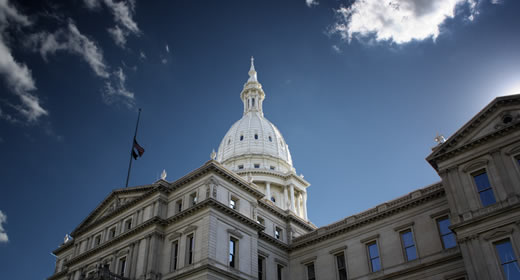
Overall, the fiscal health of Michigan's local governments appears to have improved slightly since last year, according to a new survey by University of Michigan researchers.
Across the state, 35 percent of the local government leaders surveyed say they're better able to meet their fiscal needs now than they were last year. That's up from 31 percent who said the same in 2016. Meanwhile, 18 percent said they're less able to meet their needs this year, down from 22 percent last year (the remaining jurisdictions answered "don't know" or "neither better nor less able to").
The data come from the Michigan Public Policy Survey, a biannual poll of Michigan's local governments. Officials from more than 1,300 cities, counties, townships and villages participated in the study, conducted by the Center for Local, State, and Urban Policy at U-M's Gerald R. Ford School of Public Policy.
The marginal improvement in the fiscal picture is a reversal of an unexpected downward tick the researchers saw last year. CLOSUP started tracking the fiscal health of local jurisdictions in 2009 at the height of the Great Recession.
"Every year since 2010, it had gotten better," said Thomas Ivacko, CLOSUP program manager. "Then last year, things got worse, which surprised us. We've been waiting to see whether that was the start of a new downward trend. It turns out it wasn't, at least not at the 10,000-foot view."
The gains this year were mostly in smaller jurisdictions, with large jurisdictions seeing less overall improvement, or even net declines.
At the same time, numerous measures have not yet returned to the high points set in 2015, and Ivacko remains disappointed that the financial recovery has taken this long.
"The more time goes by, the closer the next recession comes," he said. "We had hoped to see better improvements in fiscal health by now. Jurisdictions, particularly larger ones, will have fewer options available when the next recession hits."
Key findings include:
- 63 percent of Michigan local governments self-rate their current level of fiscal stress as relatively low, although this is down slightly from 64 percent last year and 66 percent in 2015. Meanwhile, local leaders in 9 percent of Michigan jurisdictions say that they are currently experiencing relatively high levels of fiscal stress, up slightly from 8 percent last year and 7 percent in 2015.
- Michigan's smaller jurisdictions were more likely to report net improvements in their ability to meet their fiscal needs, while larger jurisdictions were more likely to hold steady or decline, overall.
- Across the state, officials report that increased needs in infrastructure will outpace increased spending in the coming year.
- Officials who characterize their jurisdictions as "mostly rural" are the most likely to rate fiscal stress as low (68 percent), while those in "urban" jurisdictions are the most likely to rate stress levels as medium or high (47 percent).
- 51 percent predict general business conditions in their local economy will be good in the coming year, the highest percentage since this survey began in 2009. And 8 percent predict bad times, the lowest percentage since 2009.
However, despite optimism about local economic conditions in general, just 29 percent believe their own local governments' fiscal health will improve, while 22 percent believe it will decline in the next year.
In mid-sized to larger jurisdictions especially, concerns about their levels of general fund balance have increased. And jurisdictions with between 10,001 and 30,000 residents particularly reported an increase in high fiscal stress, from 5 percent last year to 12 percent today. One reason larger jurisdictions might be struggling, Ivacko says, is that they have more fluctuations in their fiscal health due to having more obligations and more rapidly rising costs than smaller entities.
In addition, the state's system of funding local governments constrains revenue growth for local governments across the state, especially property tax revenue growth, which is local jurisdictions' most important source of funding. At the same time, only 17 percent of local jurisdictions report an increase in state revenue sharing and other aid to local governments this year, while 19 percent report cuts in such revenue.
"There's a disconnect. Even though local officials report improving economic conditions in communities across the state, in many cases their own governments' fiscal fortunes are lagging behind," said Debra Horner, project manager on the MPPS program.
MPPS surveys were sent April 3-June 2, 2017, via hard copy and the internet, to the top elected and appointed officials in all counties, cities, villages and townships in Michigan. A total of 1,372 jurisdictions returned valid surveys, a 74-percent response rate. The margin of error for the survey as a whole was 1.3 percent.